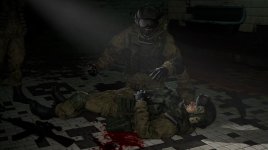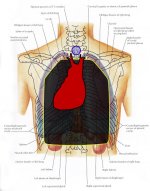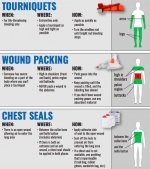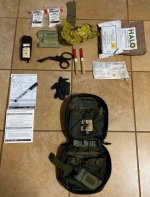Kolobok Medical Roleplay Guide
Introduction
Greetings and welcome to the Kolobok Stalker Roleplay MedRP guide. The purpose of this guide is to improve the roleplay of treating injuries within the server. You might be wondering who I am to even write this guide. I am Geist, a staff member and long time roleplayer. I am a former Basic Emergency Medical Technician, and in my current line of work I am certified in Tactical Combat Casualty Care (TCCC). Throughout my career in public service I have received a fair amount of training, and experience, in treating traumatic injuries including gunshot wounds. In this guide I'll go over basic anatomy and physiology, various types of injuries, and the basic methods of treating them. Keep in mind that you may roleplay however you see fit, and you are not required to roleplay to the depth this guide will cover.
As a disclaimer, nothing in this guide should be considered medical advice, and the contents of this guide are ONLY intended to improve roleplay within our Garry's Mod STALKER roleplay server. If you are interested in emergency medicine, you should seek your own training through persons certified to do so.
Anatomy and Physiology
To oversimplify things, ventilation moves air in and out of the body. Respiration moves oxygen to the cells and removes carbon dioxide. Your circulatory system pumps blood. Arteries carry oxygen rich blood away from the heart, and veins carry 'used' or deoxygenated blood laden with carbon dioxide back to the heart. The goal is to perfuse the cells with oxygen and nutrients, and remove waste. When the body is not properly perfused with oxygen, 'shock' (Or hypoperfusion) occurs. There are four types of shock.
Hypovolemic Shock occurs when a significant volume of blood is lost from the cardiovascular system. (Is in massive bleeding) Too little volume results in decreased pressure within the cardiovascular system. Without adequate pressure, the heart has difficulty pumping enough blood to all the necessary regions of the body and cells become hypoperfused. Lost blood also means less oxygen is circulated, further increasing the oxygen deficit in the cells. Hypovolemic is likely the most common form of shock you will encounter when treating injuries on the server.
Distributive Shock occurs when the smooth muscle of the blood vessels lose their ability to maintain a normal diameter. Some condition (Such as poisoning by certain chemical weapons) causes vessels which are normally constricted to rapidly dilate, decreasing the pressure within the cardiovascular system. As mentioned above, the low pressure means the heart cannot adequately pump oxygenated blood and hypoperfusion occurs.
Cardiogenic Shock occurs when the heart fails in its ability to pump blood. The heart is either beating irregularly, or has suffered damage as a result of infarction or trauma (such as a cardiac tamponade) and now cannot pump effectively, resulting in hypoperfusion.
Obstructive Shock occurs when blood is physically prevented from flowing (Such as with a pulmonary embolism) Large volumes of blood are prevented from reaching vital areas, resulting in hypoperfusion. You will likely not encounter obstructive shock on the server.
Shock causes the body to rapidly adjust and attempt to compensate for the hypoperfusion. The brain recognizes the need for compensation and signals a 'Fight or Flight' response that forces the body into an overdrive in order to compensate. This compensation occurs as heart rate and respiratory rates increase to move more oxygen to the body, blood vessels constrict to increase pressure, and direct blood flow to vital organs. Hormones are also released to stop the kidneys from eliminating fluid, and bone marrow to increase production of red blood cells. Generally, these steps can buy the body time to correct the cause of the shock. This is called Compensated Shock.
When assessing a patient, compensated shock may present as: Increased heart and respiratory rate, weak peripheral pulses, sweating, and pale skin that is cool and clammy to the touch.
As with any overdrive, this compensation cannot be maintained indefinitely. Eventually the body will be unable to compensate if the cause of shock has not been corrected. This is called Decompensated Shock. Decompensated shock is extremely bad, and patient death is imminent unless immediate action is taken.
When assessing a patient, decompensated shock may present as: Decreased heart and respiratory rate, decreasing blood pressure, and altered mental status, or unconsciousness.
Treatment of shock should include stabilizing injuries, keeping the patient warm, oxygen administration (If available), and rapid transport to definitive medical care.
Treatment of General Injuries
There are numerous types of injuries you could encounter in the zone. These include blunt and penetrating trauma, burn injuries, and blast injuries. Some injury types will be multi-system. For exmaple, blast injuries have 4 stages. The primary stage is cause by the overpressurization shockwave, which can damage gas-filled (hollow) and soft organs such as the lungs, abdominal tract, eyes, and ears. The secondary stage is penetrating trauma caused by flying debris and shrapnel from the explosive. The tertiary stage is blunt force trauma caused by the patient being thrown from the force of the blast. The fourth stage includes the after-effects of the explosion such as burns, crush injuries from collapsing structures, etc.
In treatment of any injury, it is useful to remember the acronym M.A.R.C.H
M: Massive hemorrhage, it is critically important to control massive bleeding. This can be accomplished via tourniquet or wound packing. Apply a tourniquet to a wounded limb. A tourniquet restricts blood flow and prevents further blood loss from a serious wound. If the injury is in a junctional area such as the shoulder, groin, or buttocks, wound packing should be utilized. Wound packing is exactly as it sounds, packing the wound with gauze (Preferably with a hemostatic agent) and applying pressure until bleeding is controlled. Arterial bleeding is bright red in color, and the high pressure of the arteries causes a spurting bleed in time with the beating of the patient's heart.
A: Airway, without a controlled airway the patient will surely die. Facial trauma and airway obstruction may prevent adequate ventilation. You may wish to insert a Nasal Pharyngeal Airway (NPA) into the nose to secure a patent open airway. You can also insert an Oral Pharyngeal Airway (OPA) to prevent the tongue from occluding the airway. (For unconscious patients)
R: Respiration, it is important to ensure your patient can be adequately ventilated. The atmospheric pressure of the air around you is higher than the pressure in your chest cavity. When the chest cavity is penetrated, or when a lung is perforated through blunt force trauma or blast injury, air may seep into the chest cavity and collapse the lung. In the cases of penetrating trauma, you can sometimes hear this, hence 'sucking chest wound'. As pressure increases and the lung collapses, pressure is also applied to the heart, preventing it from adequately pumping (Remember? Cardiogenic shock!) It is important to stabilize the chest with a 'Chest Seal' which is an impermeable piece of plastic or rubber which makes the chest cavity airtight once more. Some chest seals have a one-way vent which allows air to escape the chest cavity, but not enter. After a chest seal is placed, you can also decompress the chest with a 14-gauge needle inserted into the second intercostal space, along the mid-clavicular (Middle of your collarbone) line. Most rifle caliber gunshot wounds will have an exit, so remember to roll the patient and place a chest seal on the exit if applicable.
C: Circulation, it is important to correct problems with circulation such as hypovolemic shock. This can be done through administration of fluids and TXA (Tranexamic Acid) via IV (Intravenous) or IO (Intraosseous) At this point, it is also beneficial to sweep for secondary bleeds. Another dangerous form of bleeding is venous bleeding. Although not as high-pressure as arteries, veins can still produce large bleeds which present as steadily flowing dark red bleeds. Most of the time, venous bleeding can be controlled by direct pressure, bandaging, and elevation of the wounded area.
H: Head Injury & Hypothermia, Head injury is difficult to treat in the field. Hypothermia on the other hand is an easily preventable factor in the death of many trauma patients. Hypothermia prevents the coagulation cascade which is the natural process of the stoppage of bleed via clotting or coagulation. Trauma patients can and will become hypothermic in an environment you find warm. Hypothermia very commonly occurs secondary to blood loss and hypovolemic shock. After you have packaged your patient for transport, be sure to wrap them in a blanket, coat, or any warm item you may have.
Conclusion
Keep in mind throughout your travels on our server that if you yourself become a casualty, you cannot save anyone, and you will be an additional drain of resources for your team rather than an asset. The most effective medicine is return fire. Additionally, care under fire and tactical field care is done with the intent of stabilizing the patient until the patient can be evacuated to definitive medical care. You won't be able to treat every problem in the field, and that is okay. Again, I want to reiterate that this level of medical knowledge is not required for the server. This guide only exists for you as optional reading to better understand casualty care. As always if you have any questions feel free to contact one of our staff members. Thanks for reading!
Last edited:




